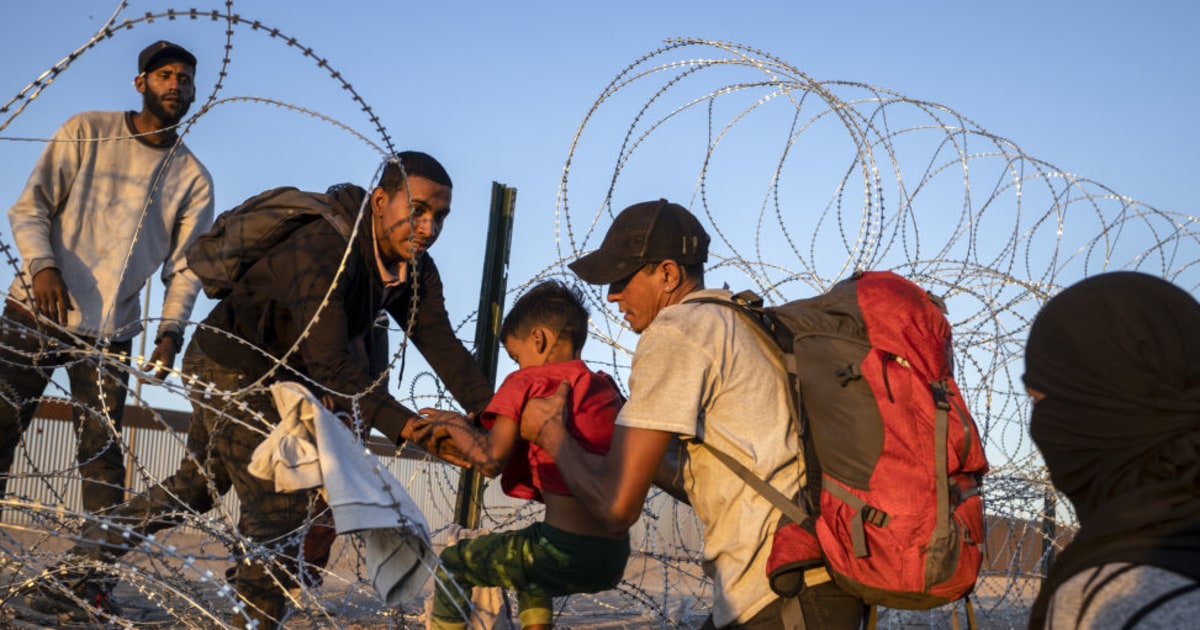By Suzanne Gamboa - NBC News
SAN ANTONIO, Texas — The possible end of Title 42 next Thursday is generating concern and alarm among authorities, communities living along the border with Mexico and migrants themselves, who do not know the impact it will have on their way north.
Below we review the main points of the law that has governed the border since 2020.
What is Title 42?
Title 42 is a part of U.S. legislation on public health, social welfare, and civil rights. It gives the federal government the authority to take emergency measures to keep communicable diseases out of the country. Before President Donald Trump invoked it in 2020 with the outbreak of the COVID-19 pandemic, it had only been used in 1929 to prevent ships from China and the Philippines from entering U.S. ports during a meningitis outbreak.
A group of migrants attempt to cross into the United States from Ciudad Juarez, Mexico, on May 7, 2023, days before Title 42 comes to an end. David Peinado / Anadolu Agency via Getty Images
The entry into force of Title 42 has allowed the expulsion of more than two million asylum seekers under the pretext of the health emergency under the governments of Trump and the current president, Joe Biden.
Why is there talk of "lifting" Title 42?
The Biden Administration had repeatedly tried to end this measure, but its plans have been delayed by the legal battle undertaken in different courts of the country before the multiple appeals presented by states governed by Republicans. The pandemic faded, casting doubt on whether Title 42 would be retained, and the Supreme Court canceled from its calendar the oral arguments that the justices were supposed to hear about the case. A federal judge in Louisiana had blocked another attempt by the federal government to undo the policy.
Why has the use of Title 42 been controversial?
Immigration groups and humanitarian activists accused the Trump administration of using the pandemic as an excuse to deny tens of thousands of people migrating to the United States to apply for asylum and receive humanitarian aid. They have also criticized the Biden administration for continuing to use it. The organizations have said the measure fuels racism and allows discrimination because some countries, such as Venezuela, had been exempt.
['There will be more severe consequences than Title 42': Mayorkas warns migrants days before health rule ends]
In October of last year, the Biden Administration began applying Title 42 to Venezuelans in October of last year, while allowing the monthly entry of 30,000 people from that country through a humanitarian parole program, which caused a decrease in the number of Venezuelans crossing the border.
In January, Mexico agreed to take in more migrants expelled from the United States, which also helped control the number of people arriving at the border. But there was an uptick in March with the anticipation of the end of Title 42 and the arrival of warmer temperatures, according to the Washington Office on Latin America (WOLA).
After a pause in migrant arrivals at the end of President Barack Obama's administration, the number of people arriving at the border has increased. Global events, economic disparities, expanding cartel smuggling operations, congressional inaction, and outdated immigration laws have brought the number of times border agents intercept people crossing the country illegally back to the numbers recorded in the early 2000s.
"We are afraid": They reinforce the border with military, asylum officers and more deportation flights
May 5, 202302:53
So will the border be open or will it not be secure if Title 42 ends?
Defining the border as "open" or not secure has more to do with political rhetoric. If Title 42 ends, the government will revert to the previous immigration law, which falls under Title 8 of the U.S. Code of Federal Statutes.
While border agents can remove people more quickly under Title 42 because they can dispense with the asylum process, migrants are not subject to the penalties they would now face under Title 8: including up to two years in prison if a person re-enters the country illegally after being removed or deported.
[At least 100 migrants found on a train in Texas. Some were arrested, others escaped and others treated for dehydration.]
Without those consequences, Mexican migrants have primarily used Title 42 "as a means to obtain multiple opportunities to enter the United States," said Ariel Ruiz Soto, a policy analyst at the Migration Policy Institute. "That's counterproductive, because it somehow incentivizes migrants to try multiple times, and the more times they try, the more likely they are to succeed," he said.
The government has been requiring people who want to apply for asylum without crossing the border illegally to make an appointment through the CBP One app, but many have been frustrated after not being able to make an appointment after several attempts, waiting in often dangerous conditions and crowded places in Mexico.
In 2019, prior to the entry into force of Title 42, only 7% of migrants apprehended by the Border Patrol had previously been intercepted. The recidivism rate increased to 27% in fiscal year 2022.
This is what the desperation of migrants to cross looks like up close while the Border Patrol watches them
May 4, 202302:08
According to the libertarian Cato institute, Title 42 has mostly been used to expel single adults from Mexico and Central American countries. Last year, nearly half of those single adults had previously been arrested under Title 42, according to Cato. In addition, the number of people who were caught crossing illegally but not arrested went under Title 42 from 12,500 a month in 2019 to an average of 50,000 last year.
Why are border and inland cities nervous about what's coming?
Even with Title 42 in place, nonprofits that run shelters in the United States, as well as officials in border towns, have had to deal with large groups of people released by Customs and Border Protection. Providing immigrants with housing, food, clothing, and help traveling to their final destinations requires money, volunteers, and space.
Some officials expect an increase in border arrivals when Title 42 ends, including those going legally to ports of entry to claim asylum. In addition, there are concerns that the increase in the number of persons and the added processing time may hamper regular movement at ports of entry.
[Biden will send 1,500 military personnel to the border with Mexico to help with the massive arrival of migrants after the end of Title 42]
On the other hand, Republicans such as the governors of Texas and Florida, Greg Abbott and Ron DeSantis, have further inflamed the situation by bus and plane transporting immigrants to cities governed by Democrats. DeSantis caused a stir when he sent two planes to Texas, which flew the migrants to Florida and then deposited them in Martha's Vineyard, Massachusetts. Abbott said in a letter that he will continue to bus people to Democratic cities after Title 42 is lifted.
What other factors affect immigration and border policy?
Congress is working on legislation to address immigration and border security, but politically a bipartisan agreement is unlikely to be reached, and most of what is being negotiated in Congress focuses only on law enforcement.
The warmer temperatures of the first and summer always influence the increase in arrivals, as well as the availability of employment and the need for labor in various industries in the United States.
At least three border cities declare a state of emergency 10 days after the end of Title 42
May 1, 202301:46
According to Ruiz Soto, focusing now on the number of immigrants arriving at the border may be obscuring the view of changes in migration patterns. In addition, in recent times there has been a change in trend with the arrival of migrants from Colombia, Ecuador and Peru.
"Our U.S. immigration system is designed to deter Mexican immigration. As migration flows become increasingly hemispheric, it is evident that our immigration system is outdated and significantly ill-equipped," Ruiz Soto said.


/cloudfront-eu-central-1.images.arcpublishing.com/prisa/AC3TY3HH2RHV7OOOEZIFQVHRV4.jpg)




